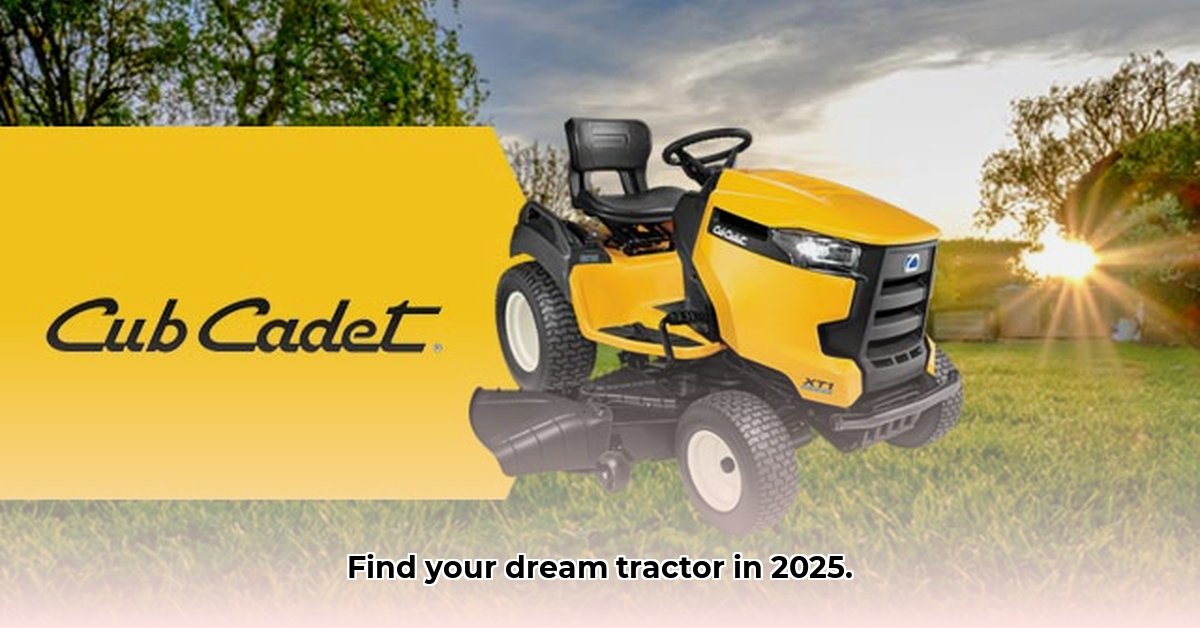
Tired of wrestling with a push mower on your sprawling lawn? Choosing the right lawn tractor can transform your yard work from a chore into a breeze. This guide helps you navigate the world of Fleet Farm lawn tractors, ensuring you find the perfect model to suit your needs and budget. We'll cover everything from assessing your lawn to understanding the nuances of different tractor types. For even more options, check out this helpful resource.
Assessing Your Lawn: Setting the Stage for Success
Before you even think about horsepower and deck sizes, take a close look at your lawn. Understanding your lawn's unique characteristics is the first step towards choosing the right tractor. This involves considering three key factors: size, terrain, and mowing frequency.
1. Lawn Size: A Matter of Scale
Use a measuring tape or an online tool to estimate your lawn's size. Accurate measurement is crucial for choosing a tractor with an appropriately sized cutting deck. Categorize your lawn into one of the following sizes:
- Small: Under 1/8 of an acre (typical city lots or small front yards).
- Medium: 1/2 to 2 acres (a standard suburban lot).
- Large: Over 2 acres (substantial acreage requiring efficient mowing).
2. Terrain Analysis: Hills, Holes, and Obstacles
Is your lawn a flat, even expanse, or does it present challenges such as slopes, hills, or obstacles? This significantly impacts the type of tractor needed. Steeper slopes often require specialized features or more powerful models.
3. Mowing Frequency: How Often Do You Cut?
How often do you plan on mowing? Weekly? Bi-weekly? Monthly? This factor influences the required engine power and, for electric models, the necessary battery capacity.
Types of Fleet Farm Lawn Tractors: A Detailed Review
Fleet Farm offers a variety of lawn tractors to fit different needs and budgets. Let's explore the key characteristics of each type:
1. Compact Tractors: Ideal for Smaller Spaces
- Key Features: Smaller engines (lower horsepower), narrower cutting decks (typically 30–42 inches), enhanced maneuverability.
- Pros: Affordable, easy to store, simple maintenance.
- Cons: Not suitable for large yards or complex terrains, slower mowing speeds for larger areas.
- Who they're for: Owners of smaller, relatively flat lawns, prioritizing affordability and ease of use. Are you tired of a slow, laborious mowing process? A compact tractor offers a significant upgrade.
2. Larger Tractors: Power and Efficiency for Larger Lawns
- Key Features: Powerful engines, wider cutting decks (42–54 inches or larger), increased cutting capacity, and additional features like mulching, bagging, or side discharge.
- Pros: Efficient mowing of larger areas, convenience of additional features.
- Cons: Higher initial cost, larger storage space required, more complex maintenance procedures.
- Who they're for: Owners of extensive lawns with varied terrain, prioritizing speed and efficiency. Do you need to cover a large area quickly and effectively? A larger tractor is your solution.
3. Zero-Turn Tractors (If Available): Unmatched Maneuverability
- Key Features: Unmatched maneuverability due to independent rear wheel controls, allowing for tight turns and precise maneuvering.
- Pros: Exceptional efficiency in intricate landscapes or large, open areas.
- Cons: Generally higher price point, steeper learning curve for operation.
- Who they're for: Owners of large lawns with complex landscaping requirements or those prioritizing precise cutting and efficiency. Are you an experienced user needing precise control? Perhaps a zero-turn is for you.
Additional Considerations: Beyond the Basics
Selecting the right tractor involves more than just choosing a model. Consider these vital factors:
1. Budget: Balancing Features and Finances
Set a realistic budget before you start shopping. Prices vary widely depending on the size, features, and engine type of the tractor. Consider the total cost of ownership, including maintenance expenses.
2. Maintenance: Keeping Your Tractor in Top Shape
Regular maintenance is crucial for extending the life of your tractor. Gas-powered models require more frequent maintenance (oil changes, blade sharpening) than electric models. Factor in the cost of maintenance when making your decision. While exact costs vary, gas mowers generally need more frequent upkeep.
3. Safety First: Prioritize Safe Operation
Always wear appropriate safety gear (sturdy shoes, long pants, eye protection) when operating a lawn tractor. Never operate on steep slopes, and always adhere to the manufacturer's safety instructions.
4. Environmental Impact: Consider Engine Type and Fuel Consumption
Gas-powered tractors produce emissions. If environmental impact is a concern, consider a fuel-efficient gas model or the potential benefits of an electric option (though their runtimes can be limited).
Choosing Your Perfect Tractor: A Decision-Making Framework
This table summarizes the best tractor types based on your lawn’s characteristics:
| Lawn Size | Terrain | Budget | Recommended Tractor Type |
|---|---|---|---|
| Small | Flat | Low | Compact Tractor |
| Medium | Flat/Gently Sloped | Medium | Larger Tractor (42-48 inch deck) |
| Large | Varied | High | Larger Tractor (50+ inch deck) or Zero-Turn |
Remember, this is a guideline; your final decision may be influenced by other factors such as specific features or personal preferences.
Ready to Make the Cut?
Armed with this information, you're well-prepared to choose the perfect Fleet Farm lawn tractor. Visit your local Fleet Farm store or browse their online catalog to explore the available options and find the ideal match for your needs and budget. Happy mowing!